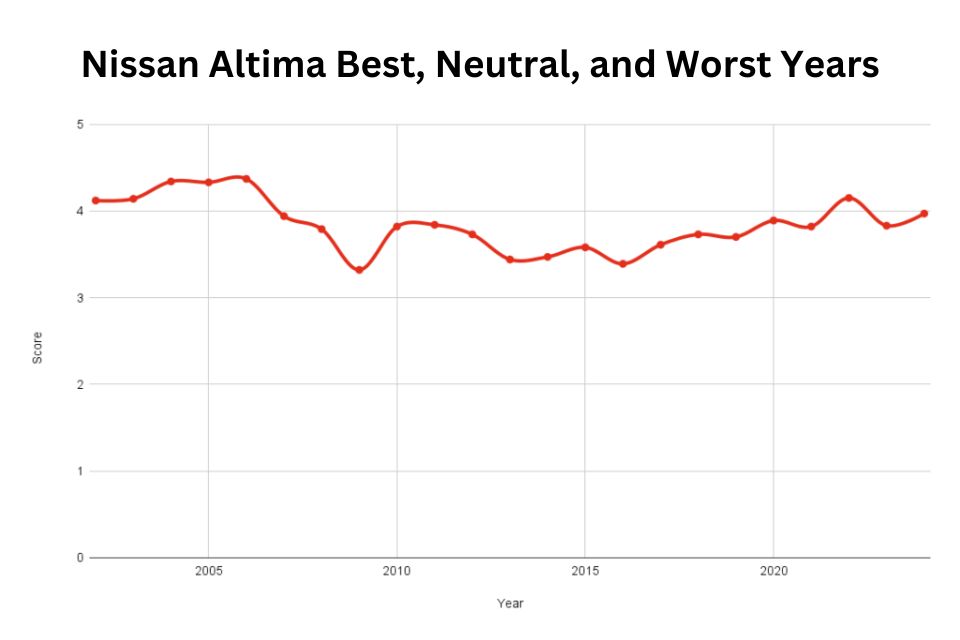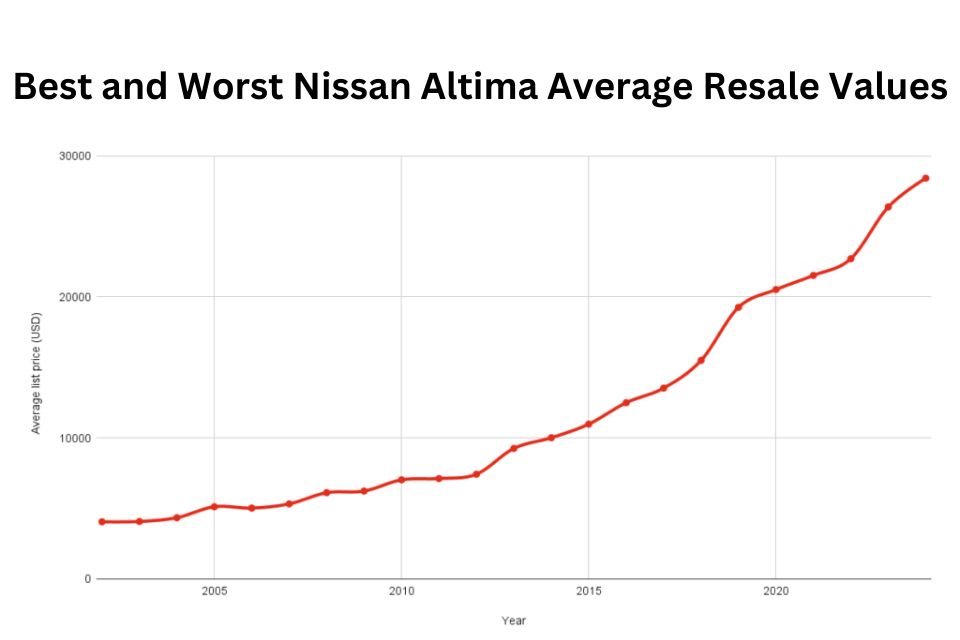The Best and Worst Nissan Altima Years has had its share of standout and lackluster years throughout its model history. Among the best is the 2013 Altima, praised for its fuel efficiency, comfortable ride, and updated technology features.
This year marked a significant redesign that boosted the Altima’s overall appeal and performance on the road.One of the worst years for the Nissan Altima is often considered to be 2002. This model year faced numerous complaints about transmission issues and reliability concerns from owners.
Despite attempts to address these problems in later versions, the 2002 Altima left a lasting mark on its reputation for mechanical troubles.While each Nissan Altima year has distinctive characteristics, prospective buyers need to weigh both positive and negative aspects when considering a purchase.
Conducting thorough research and test-driving different model years can help individuals decide based on their preferences and needs.
You can also read:- Best and Worst Nissan Rogue Years
Best and Worst Nissan Altima Generations
The best Nissan Altima generations, many enthusiasts point to the third generation (2002-2006) as a standout. This iteration featured a sleek redesign, improved handling, and reliable performance.
Its fuel efficiency and spacious interior made it a top choice in its class. The second generation (1998-2001) is often noted as one of the worst due to issues with transmission reliability and overall build quality.
Despite some positive aspects like its sporty styling, these consistent mechanical problems have tarnished its reputation among consumers.
| Generation | Years |
|---|---|
| 3rd generation (L31) | 2002-2006 |
| 4th generation (L32) | 2007-2012 |
| 5th generation (L33) | 2013-2018 |
| 6th generation (L34) | 2019-Present |
The fifth generation (2013-2018) stands out as one of Nissan’s strongest offerings in recent years. With advanced technology features, a comfortable ride quality, and available upscale amenities, this generation has garnered praise for delivering solid value for its price range.
In contrast, some critics have highlighted the fourth generation (2007-2012) as lacking in refinement compared to other models. Common complaints include subpar materials used in the interior and underwhelming driving dynamics which may not appeal to all drivers seeking a more engaging experience on the road.
Nissan Altima Best, Neutral, and Worst Years
The Nissan Altima has had its fair share of standout years, with the 2013 and 2014 models often regarded as some of the best in terms of performance and features. These generations offered a perfect blend of power, efficiency, and style that appealed to a wide range of drivers.
The 2002 and 2003 models have been labeled as some of the worst for their reliability issues and lackluster build quality. Common complaints included transmission problems and engine issues that plagued many owners during this period.

While still popular among budget-conscious buyers, these years fell short in comparison to other more successful generations.
Neutral ground can be found with the 2017 model year which introduced a complete redesign aimed at modernizing the Altima’s look and feel. While it received mixed reviews from critics, it offered decent performance upgrades and technology advancements that kept it competitive in its class.
Overall, each year brings its own set of pros and cons, making the Nissan Altima a versatile option for those in search of a reliable midsize sedan.
Best and Worst Nissan Altima Years of 3rd Generation (2002-2006)
The Nissan Altima’s third generation, spanning from 2002 to 2006, saw some notable highs and lows in terms of performance and reliability. One standout year was the 2005 Altima, praised for its responsive handling and powerful V6 engine option.
Its sleek design also appealed to many buyers looking for a stylish midsize sedan.The 2002 Altima suffered from various transmission issues that plagued its reputation.

In contrast, the 2003 model year of the Nissan Altima had a mixed reception among consumers. While it offered a comfortable ride and spacious interior, it was criticized for its lackluster fuel efficiency and overall build quality compared to other years in the range.
Despite these drawbacks, the 2004 Altima redeemed itself with improved fuel economy and enhanced safety features, making it one of the more well-rounded options within this era of Nissan’s popular sedan.
The Best Years: 2004
The year 2004 stood out as a defining time for the Nissan Altima, with significant improvements over previous years. This was when the 3rd generation of the Altima hit its stride, offering a perfect balance of performance, style, and reliability.
While some critics have pointed out issues with transmission in earlier models, 2004 saw enhancements that addressed these concerns, making it one of the best years for this iconic vehicle.
Owners of the 2004 Nissan Altima rave about its smooth ride, spacious interior, and fuel efficiency. With a sleek design and advanced features for its time, including keyless entry and power accessories.
The 2004 model remains highly sought after by those looking for a dependable daily driver or stylish family car. In retrospect, it’s clear that 2004 was truly one of the shining moments for the Nissan Altima during its third generation.
The Neutral Years: 2005, 2006
In the neutral years of 2005 and 2006, the Nissan Altima found itself at a crossroads between its best and worst performances of the third generation. This period marked a time of stabilization for the model, with minor updates and improvements that kept it competitive in the midsize sedan market.
While some critics may argue that these two years lacked significant advancements compared to previous models, others appreciate the consistent quality and reliability that were maintained.
Despite facing tough competition from rival brands during this time, the Nissan Altima continued to showcase its strengths in performance and handling. The subtle modifications made to the exterior design and interior features helped maintain its appeal to loyal customers while also attracting new buyers seeking a dependable but stylish vehicle.
Overall, while 2005 and 2006 may not stand out as exceptional years for the Nissan Altima, they played an important role in setting the stage for future successes within the brand’s lineup.
The Worst Years: 2002, 2003
The years 2002 and 2003 were indeed a challenging time for Nissan Altima enthusiasts. Despite the initial excitement surrounding the release of the third-generation model, these two years saw an increase in complaints regarding various mechanical issues.
From transmission failures to engine problems, many owners experienced unexpected and costly repairs during this period.Amidst the challenges faced by Nissan Altima owners in 2002 and 2003, there is still room to appreciate the improvements that were made to the car’s design and performance capabilities.
Despite some setbacks, these models introduced innovative features that set the foundation for future advancements in technology and engineering within the automotive industry.
While it’s undeniable that 2002 and 2003 presented their fair share of difficulties for Nissan Altima owners, it’s important to remember that every setback is an opportunity for growth and improvement.
The lessons learned during these tough times have undoubtedly paved the way for a more robust and reliable line of vehicles in subsequent years.
Best and Worst Nissan Altima Years of 4th Generation (2007-2012)
The best and Worst Nissan Altima years of the 4th generation (2007-2012), one standout model is the 2010 Altima. Known for its fuel efficiency, smooth ride, and attractive design, the 2010 Altima offers a balanced combination of performance and reliability.
Another top contender is the 2008 Altima, lauded for its sporty handling and spacious interior, making it an ideal choice for both daily commuting and road trips.

On the flip side, one of the least favored models from this generation is the 2007 Nissan Altima. Critics have highlighted issues with its continuously variable transmission (CVT) which could lead to costly repairs down the line.
The 2011 Altima has received mixed reviews due to ongoing problems with its electrical system and overall build quality. It’s important for potential buyers to carefully consider these factors when looking into purchasing a Nissan Altima from this era.
The Best Years: 2010, 2011, 2012
The years 2010, 2011, and 2012 marked a significant period for the Nissan Altima during its 4th generation. While these years saw improvements in performance and design, there were also notable drawbacks to consider.
The 2010 model year stood out with its sleek exterior and comfortable interior, providing a pleasant driving experience for many owners. Some reported issues with transmission reliability raised concerns among enthusiasts.
The 2011 Nissan Altima garnered praise for its fuel efficiency and refined handling, making it a popular choice among drivers looking for a reliable midsize sedan. Despite these positive attributes, certain models suffered from electronic glitches and suspension problems that impacted overall satisfaction.
Moving on to the year 2012, the Nissan Altima showcased innovative technology features but faced criticism for its limited cargo space compared to competitors in the segment. Nonetheless, this period of continuous evolution laid the groundwork for future advancements in Nissan’s lineup.
The Neutral Years: 2007
The year 2007 marked a pivotal time for the Nissan Altima, residing in what has been dubbed as the Neutral Years of its 4th generation. This era brought both praise and criticism to the Altima, positioning it as a middle-ground contender in the competitive sedan market.
While some lauded its sleek design and responsive handling, others critiqued its lackluster fuel efficiency and interior quality.Amidst this mixed feedback, the 2007 Nissan Altima stood out for its overall reliability and driving dynamics.
Many owners appreciated its comfortable ride and ample power provided by the V6 engine option. some found fault in its outdated technology features compared to rival models of that time.
Despite these shortcomings, the 2007 model year served as a transitional phase for the Altima, setting the stage for future improvements in subsequent years of the generation.
The Worst Years: 2008, 2009
The years 2008 and 2009 were challenging times for Nissan Altima owners, as these models faced some major setbacks in terms of reliability and performance. Issues with the transmission systems plagued many vehicles during these years, leading to costly repairs for unsuspecting drivers.
Despite these challenges, it’s worth noting that not all Altima models from this period experienced such issues. Some owners reported satisfactory performance and overall satisfaction with their vehicles, demonstrating that individual experiences may vary.
Looking back at these troubled years highlights the importance of thorough research and maintenance when considering purchasing a used Nissan Altima from this era. As newer models continue to improve upon past flaws, consumers need to stay informed and make educated decisions when selecting a vehicle in the ever-evolving automotive market.
Best and Worst Nissan Altima Years of 5th Generation (2013-2018)
The Nissan Altima’s 5th generation, from 2013 to 2018, some standout years have thrilled drivers while others may have left them underwhelmed. The 2016 model year shines with its upgraded infotainment system and smooth ride quality, making it a top pick for those who value technology and comfort.

The 2013 Altima has faced criticism for its less refined driving experience and inconsistent build quality, which may deter some buyers seeking reliability.The 2017 Nissan Altima impresses with its revised styling and enhanced safety features, offering a more refined and modern driving experience that resonates with many consumers.
The 2014 model year falls short in terms of handling dynamics and interior materials quality compared to its counterparts in this generation. By weighing these factors carefully, prospective buyers can navigate through the best and worst years of the Nissan Altima’s 5th generation to find the perfect match for their needs and preferences.
The Best Years: 2017, 2018
The Nissan Altima, the years 2017 and 2018 stand out as some of the best in the fifth generation. These model years brought significant improvements in terms of technology, comfort, and performance.
With sleek designs and enhanced safety features, the Altima proved to be a strong contender in its segment during these years.It’s essential to note that there were still some shortcomings during this period.
Some owners reported issues with transmission reliability and suspension components. Despite these drawbacks, the overall reputation of the Altima remained positive thanks to its fuel efficiency and user-friendly infotainment system.
Looking back at 2017 and 2018, it’s clear that these years marked a period of innovation and refinement for the Nissan Altima in an ever-evolving automotive landscape.
The Neutral Years: 2016
In the automotive world, the 2016 Nissan Altima stands out as a paradox – a year of neutrality within the robust fifth generation. While some critics might argue that 2016 didn’t bring significant changes to the Altima lineup, others appreciate its consistency and reliability.
This model year offered a smooth driving experience with decent fuel efficiency yet lacked any groundbreaking advancements that could have set it apart from its predecessors.
Looking at consumer feedback, the 2016 Nissan Altima falls somewhere in the middle when compared to other years in the same generation. Many drivers appreciated its comfort and practicality but noted that it didn’t push boundaries or offer any remarkable features.
As we reflect on this ‘neutral’ period for Nissan’s popular sedan, it’s clear that sometimes staying true to a formula can be both a strength and a limitation in an ever-evolving market landscape.
The Worst Years: 2013, 2014, 2015
The years 2013, 2014, and 2015 marked a turbulent period for the Nissan Altima in its 5th generation. Despite being popular choices among consumers, these years were plagued by various technical issues and recalls that tarnished the vehicle’s reputation.
From transmission problems to faulty airbags, the Altima faced criticism for its lack of reliability during this time.In terms of performance, the engine power in the Altima during these years was often deemed underwhelming compared to its competitors.
Interior quality and design fell short of expectations with cheap plastics and outdated features becoming prevalent complaints among drivers. The overall consensus was that the Altima models from 2013 to 2015 failed to deliver on both style and substance, leading to a decline in customer satisfaction and rankings within its class.
Best and Worst Nissan Altima Years of 6th Generation (2019-Present)
The 6th generation Nissan Altima, the 2019 model year stands out as one of the best options available. With a sleek new design, updated technology features, and impressive performance, the 2019 Altima offers a great overall driving experience.

Some drivers have noted concerns with the continuously variable transmission (CVT) in this model year, leading to mixed reviews.The 2020 Nissan Altima has received positive feedback for its refined interior quality and comfortable ride.
With added standard safety features and improved fuel efficiency, this year’s model offers a strong value proposition for buyers. Despite these improvements, some customers have reported issues with cabin noise levels and visibility from inside the vehicle.
The Best Years: 2021, 2022, 2023, 2024
The best and worst Nissan Altima years of the 6th generation, eyes are naturally drawn towards 2021, 2022, 2023, and 2024. These years mark a significant evolution in design, technology integration, and overall driving experience for this beloved sedan.
The sleek exterior updates coupled with advanced safety features make these years stand out as leading choices for Altima enthusiasts.While all four years boast impressive upgrades and improvements compared to earlier models.
Some critics argue that certain variants in these years suffer from minor performance issues or lackluster interior finishes.It’s essential to note that advancements in engine efficiency and handling dynamics have also been notably enhanced during this period.
If you’re seeking a sophisticated blend of style and substance with your Nissan Altima choice during the 6th generation reign, exploring the nuances within each year can truly lead you to your perfect match.
The Worst Years: 2019, 2020
In the world of Nissan Altima cars, the years 2019 and 2020 came with their own set of challenges and controversies. While many praised the sleek design and updated features of these models, others criticized issues related to transmission problems and reliability concerns.
Despite some standout qualities, such as improved fuel efficiency and enhanced safety technology, both years left some owners feeling disappointed in terms of overall performance.
It’s important to note that every car model goes through its share of highs and lows over time. The 2019 and 2020 Nissan Altima may have faced criticism in certain areas, but they also showcased advancements in technology integration and driver-assist systems.
As we look back on these worst years for the Altima line, it becomes clear that even amidst challenges, there were still valuable lessons learned for future improvements in subsequent model releases.
Best and Worst Nissan Altima Average Resale Values
The resale value of Nissan Altima models, some years stands out more than others in terms of retaining their worth on the market. The 2017 Nissan Altima has been praised for its strong resale value, thanks to its reliable performance and attractive design.

The 2012 Nissan Altima tends to have a lower resale value due to increased wear and tear over time.Interestingly, newer models like the 2020 Nissan Altima are also showing promising resale values, indicating a positive trend for future depreciation rates.
Older models such as the 2008 Nissan Altima may struggle more on the resale market due to their age and outdated features. Understanding these trends can help both buyers looking for a good deal and sellers aiming to maximize their returns in the competitive automotive market.
Conclusion
The Best and Worst Nissan Altima Years has a rich history of both impressive and lackluster model years. From the reliable and fuel-efficient early 2000s models to the sleek and tech-savvy recent releases, there is a wide range of options to choose from.
It is important for buyers to carefully consider factors such as reliability, performance, and safety ratings when selecting a specific year model. By conducting thorough research and test-driving different years of the Nissan Altima, consumers can make an informed decision that best suits their needs and preferences.
Whether you are in the market for a dependable daily driver or a stylish upgrade, exploring the best and worst Nissan Altima years will help guide you toward making the right purchase.
FAQ
Q: What is the best year for the Nissan Altima?
A: The 2019 Nissan Altima is widely regarded as one of the best years due to its redesigned look and new features.
Q: Which Nissan Altima year should I avoid?
A: The 2002 Nissan Altima is often considered one of the worst years due to reported transmission issues.
Q: Is the 2015 Nissan Altima a reliable choice?
A: Yes, the 2015 Nissan Altima is known for its reliability and overall good performance.
Q: Are there any standout features in the 2020 Nissan Altima?
A: The 2020 Nissan Altima offers advanced safety features like ProPILOT Assist and a spacious interior cabin.
Q: How does the fuel efficiency of the 2018 Nissan Altima compare to other years?
A: The 2018 Nissan Altima has excellent fuel efficiency, making it a cost-effective choice compared to some older models.

